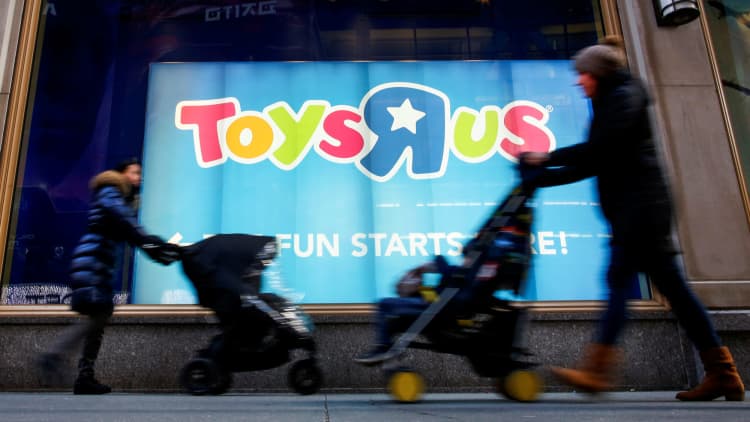
Toys R Us made official its liquidation on Thursday morning, filing documents with the bankruptcy court that will lead to the sale or closing of its roughly 800 U.S. stores.
It ends a chapter started by Charles P. Lazarus, the son of a bicycle shop owner, the store's visionary, who wanted the "R" written backwards — an ode to childlike scrawl.
"This is a profoundly sad day for us as well as the millions of kids and families who we have served for the past 70 years," CEO Dave Brandon said in a statement.
It is a blow to the toy industry, which has relied on the retailer for supplying row after row of toys and premium pricing, and who now must look to big box stores and Amazon.
It is a black-eye for its its three owners, KKR, Bain Capital Partners and real estate investment trust Vornado Realty Trust, who took the retailer private in 2005 for $6.6 billion, leaving it with $4.9 billion in debt. That debt would become an anathema for the business, keeping it from making the investments it needed as the retail landscape rapidly transformed around it.
The debt, of course, was what ultimately did the company in. Under its onerous weight and with little hope of refinancing it, Toys R Us hired restructuring advisers in 2017. The plan was to put together pre-packaged bankruptcy for after the holiday season in advance of upcoming payments due, sources tell CNBC.
But when CNBC broke news that it may file, it caused a run on the bank. Vendors froze their shipments to Toys R Us, only accepting cash on delivery. In weeks, it was forced to file for bankruptcy before its crucial holiday season and without a plan to emerge. A miserable holiday season would be the nail in its coffin.
U.S. holiday sales produced earnings that were $250 million below budget projections, according to court filings. It blamed the uncertainty surrounding its chapter 11, price-cutting rivals and weakened e-commerce business. The holiday season left it unable to ensure it would be able to continue to satisfy the terms of its bankruptcy loan.
Meantime, a separate group of lenders had been pushing it toward liquidation.
"The stark reality is that the debtors are projected to run out of cash in the U.S. in May 2018," the court filing read.
The company may be able salvage 200 stores to operate under the Toys R Us brand in the U.S., in a deal the company has been shopping together with its Canadian business. The new entity would be operated out of Canada. It is in talks with several parties about the potential deals, including some of its lenders.
Toys R Us also said Thursday it is pursuing a reorganization and a sale process for its businesses in Asia and Central Europe, including Germany, Austria and Switzerland. Its businesses in Australia, France, Poland, Portugal and Spain are considering their options, including a potential sale.
Missed Opportunities
The challenges that were ultimately Toys R Us' undoing had been decades in the making, according to multiple conversations with industry executives and employees.
Years of being the most important toy store in town left it cavalier, according to those former employees and industry insiders. They said it didn't take care of its store base — whether that meant pruning stores that weren't making money, or putting resources toward those that were. It also under-invested in its digital business even as e-commerce skyrocketed, those sources told CNBC.
"Experiential" has become a buzz word among retailers trying to compete with internet, but Toys R Us's struggles to translate the joy of toys into something more tangible in its stores would ultimately be one of its biggest missed opportunities.
Another would be losing touch with its core customers: mothers shopping for their children.
"I remember when I first got there, walking into the first meeting with the executive committee thinking, 'This is going to be interesting. Our target audience is moms with kids, and I just walked into a room of guys with ties,'" said Warren Kornblum, who worked as chief marketing officer in the late 1990s and mid-2000s.
Toys R Us could have, for example, moved faster into online white glove service for its Babies R Us business, making it easier for a pregnant woman to receive the delivery of her crib.
One former employee recalled asking why Toys R Us did not have a catalog like Sears. She was told that mothers could come into the store to shop for the kids, but she knew that working mothers might not have the time.
With those shortcomings, Toys R Us was unprepared for the competition it never saw coming. Big box stores first undercut it on prices, and later online retailers offered the capabilities it had never built up. A failed partnership with Amazon that ended in litigation only served to further set back its digital business.
It was under that pressure and swooning stock price that Toys R Us sold to financial buyers, in hope of salvaging its value. But the debt brought with it new problems and time saw a further onslaught of competitors. The toy industry itself rapidly changed, as iPhones flooded the market.
Ultimately, it would all be too much.


